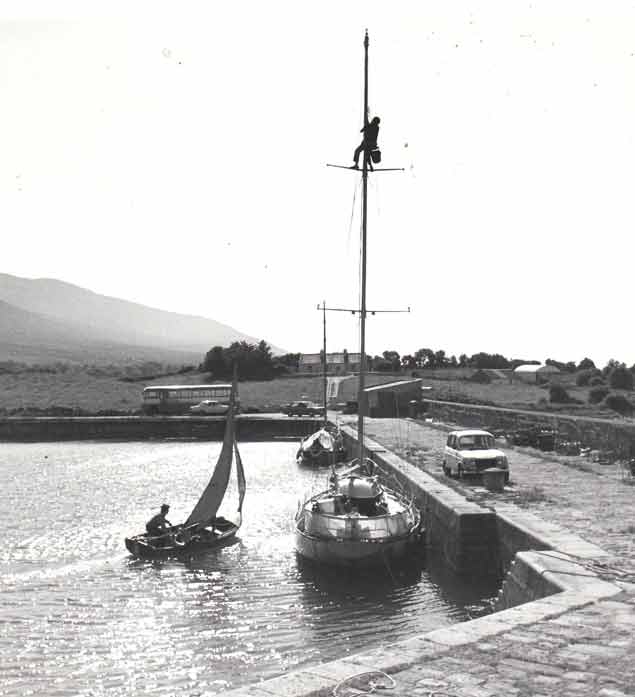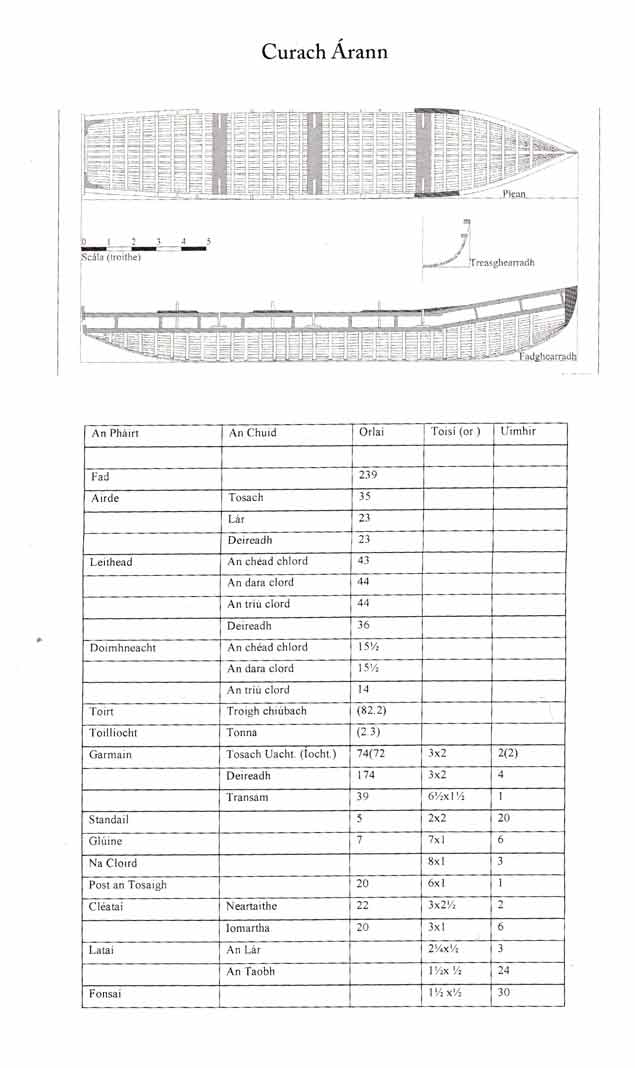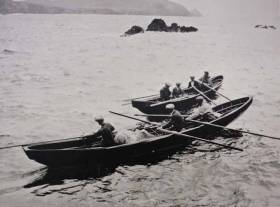Displaying items by tag: curach
History of Irish Curach in Irish is Unique Publication
There’s something about the magnificent West Coast of Ireland that produces larger-than-life characters of prodigious energy writes W M Nixon. And James Cahill of Mayo is one of them. Way back in 1974, he sailed round Ireland in a 13ft 6ins clinker-built open sailing dinghy, sometimes with a friend as crew, sometimes single-handed. Whatever about the size or otherwise of the ship’s complement, it was all done without any support vessel whatever.
Then he got the idea of the Atlantic triangle cruise, so he built himself a handsome and hefty steel cruiser for the project, and he did it. And by the time he returned, there was a Cahill family in the making, so he settled back again on the shores of Clew Bay, and buckled down to domesticity and work.
But with that extra Cahill energy, he also found the time and space for other things. Thus when he had ascertained that there are thirteen different identifiable types of traditional skinned-hull curachs to be found in Ireland (he spells it with just the one “r”), he set to and built one of each himself, to be preserved for us all in his own private collection of thirteen curachs.

So although he now also has something of a flotilla of larger more modern craft, the curachs have always had a special place in his heart. And when he heard that a book of the complete story of the curach had been written by the former Principal of the Sligo Institute of Technology Dr Brendan Caulfield – and in Irish too, which is very rare for a maritime book – he decided the world should know more about it, so he forwarded us a copy, and obligingly included a review-cum-guide in Irish and English by Dr Caulfield’s son Oisin.
We’ll let Oisin’s review speak for itself, as he makes some unexpected points of special interest. Bur we can’t let it go that Dr Caulfield assesses that there are fourteen different identifiable Irish curach types, which is good news for those of us who might incline to be superstitious about James Cahill’s reckoning of thirteen.

Curaigh na hÉireann – a stair agus a scéal.
Breandán Mac Conamhna
Foilsitheoir Cló Iar Chonnachta
Is stair mhuirí chósta iarthair na hÉireann í an saothar tábhachtach seo, scríofa i nGaeilge, a fhiosraíonn an pháirt láirneach atá ag an gcurach in oidhreacht mhuirí na hÉireann. Is iar-stiúirtheoir é an t-údar ar IT Shligigh, a chaith roinnt maith bliana ar an staidéar seo, agus leabhar eile foilsithe aige cheana fhéin faoin gcurach óna áit dhúchais fhéin ar chósta thuaidh Mhaigh Eo.
Ríomhann an leabhar stair an churaigh, ó na tagairtí clasaiceacha agus ó na hAnnála is luaithe, tríd na himmrámha agus faoi “impireacht an churaigh” timpeall an Mhuir Éireann le linn na Ré Dorcha, go dtí forbairt an churaigh traidisiúnta san naoú haois déag. Déanann sé cur síos ar a thábhacht mar an príomhshoitheach iascaireachta ar feadh breis agus céad bliain, agus leanann sé a fhorbairt agus a áit i bpobal chósta an iarthair go dtí an lá atá inniu ann.
In éacht suntasach de scoláireacht nua, cuireann sé béim ar an bpáirt riachtanach a ghlac oifigí fórsaí armtha na Breatainne i fhorbairt an churaigh traidisiúnta, ag cur na teicnící agus ábhair na Réabhlóide Tionsclaíochta i bhfeidhm ar dhearadh Nua Aoise na gCloch, de chiseán caoladóireacht clúdaithe le seithí. Go háirithe, léiríonn sé gurb é an Ginearál Affleck a bhí freagrach as garmain sáfa agus tairní iarann a thabhairt isteach; agus do cheap Lieutenant Traxton den Chabhlach Ríoga ar an gclúdach canbhás tarráilte. Bhí an nuálaíocht seo thar a bheith tábhachtach, mar gheall ar a thoradh eacnamaíochta; ina dhiaidh, bhí na teaghlaigh bhochta ar chósta an iarthair abálta líon a shaothrú chun clúdach an churaigh a thóigeáil, in áit an praghas ró-ard a n-íoc ná aon bheitheach a bhí acu a mharú chun a sheithe a fháil. Teasbánann an t-údar – trí léiriú mionsonraithe ar an gcomhchoibhneas atá ann idir na chineál curaigh atá ann leis na rannóga stairiúla de Gharda Chósta na Breatainne – go raibh an Gharda Chósta freagrach as an dearadh nua a scaipeadh agus a chur chun cinn ar fud an chósta, i gcúnamh mór do na pobail bochta. Leanann sé scaipeadh an churaigh nua trí anailís ar an athrú a tháinig ar an mheáinchriú de réir rannóga an Gharda Chósta, foinsithe ó na tuairiscí iascaireachta agus ón Gharda Chósta ón naoú haois déag.
Sa dara chuid den leabhar, tá suirbhé iomlán de gach saghas de churaigh atá ann inniu, agus curachán na Bóinne chomh maith, le saibhreas mór de stair mhuirí agus sóisialta, léirithe i ngach áit le grianghraif stairiúla. Tá téarmaíocht áitiúil a mbaineann leis an gcurach bailithe ag an údar ar a thaisteal go gach port an churaigh ar chósta an iarthair, agus tá taifead déanta aige de i ngach caibidil. Críochnaíonn an leabhar le cúpla aguisín, le pleananna mionsonraithe de gach saghas de churaigh, agus treoir praiticiúil chun curach a thóigeáil.
Ba chóir don leabhar seo a bheith I leabharlann gach duine a bhfuil suim acu i stair mhuirí na hÉireann. Mar gheall ar an saibhreas atá sna foclóirí de téarmaíocht áitiúil nach bhfuil ar fail in aon áit eile, bheadh suim ag scoláirí na Gaeilge ann chomh maith.

This important book is a maritime history of the west coast of Ireland, written in the Irish language, which explores the central role played by the curach in Ireland’s maritime heritage. The author, a former director of IT Sligo, has devoted many years to this study, having already published a book on the curach on the north Mayo coast, where he was born.
The book traces the history of the curach, from the earliest classical and annalistic records, through the immrámha and the Dark Age “empire of the curach” around the Irish Sea, to the development of the traditional curach in the nineteenth century. It explores its importance as the primary fishing craft on the west coast for over a century, and follows its development and its place in coastal communities to the present day.
In a significant contribution of original scholarship, it highlights the central role played by officers of the British armed forces in the development of the traditional curach, in applying the techniques and materials of the industrial revolution to the Neolithic design of a hide-covered wicker basket. In particular, it shows how General Affleck was responsible for introducing sawn gunwales and iron nails, and how Lieutenant Traxton of the Royal Navy was responsible for the introduction of a tarred canvas cover.
Before that, valuable animal skins had to be used. This crucial innovation, which had far-reaching economic consequences, meant that impoverished families of the western seaboard could grow flax to make linen which was then tarred when the boat was covered, rather than being faced with the prohibitive expense of slaughtering whatever livestock they possessed for their hides.
The author proceeds to show – by a detailed demonstration of the correlation of extant curach types with historical UK coastguard districts – how the coastguard was responsible for the introduction and promotion of the new curach design along the western seaboard, in a material contribution to the well-being of its disadvantaged communities. The propagation of the new design is traced by an analysis of the change in average crew size by coastguard district, sourced from nineteenth century fisheries reports.
The second part of the book consists of a comprehensive survey of all the extant curach types, as well as the Boyne coracle, supplemented by a wealth of maritime and social history, illustrated throughout with historical images. Local Irish words of curach terminology, sourced by the author in his travels through all the curach ports of the west coast, are recorded in each chapter.
The book concludes with a set of appendices, containing detailed plans of every curach type, and practical instructions for building a curach. This book deserves a place on the shelves of everyone with an interest in Irish maritime history. Because of its wealth of local vocabulary which is unrecorded anywhere else, it will also be of interest to scholars of the Irish language.




























































